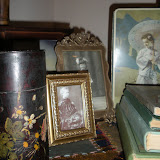| Japonisme |
(Click on photo above to view Cassandra's collection.)
Japonisme or Japonaiserie are the original French terms for the influence and assimilation of the Japanese aethetic on the arts and design of the West in the mid to late 19th century. When contact between the West and Japan started after the arrival in Japan of Commodore Perry in 1853, ending a period of Japanese isolation, a period of assimilation of Japanese styles by European artists and artisans commenced in the areas of design and construction, furniture (Herter), sculptures, porcelain/ceramics (Gallé, Rookwood), glasswork (Tiffany, LaFarge), jewelry (Lalique), silver (Gorham, Tiffany), wallpaper/prints/textiles (Liberty), and book design (esp. Sarah Wyman Whitman, Margaret Armstrong, and Bertha Stuart).
During the 1860s and 1870s, various Japanese products, both new and old, swept through Europe, and various traders, diplomats and travelers returned from their travels to Japan to publish books and spread their knowledge of Eastern life and culture. Thus, the elegance and simplicity of Japanese style, design and production greatly inspired English and French artisans, who ultimately worked to fuse Japanese aesthetic values with Victorian functional needs. This assimilation and fusion of styles allocated "new ideas and shapes that looked towards the 20th century". The Japonisme influence ultimately molded and directed the progression of the Aesthetic Movement and unleashed a fervor of desire for this "new style". Larger artistic movements such as Arts and Crafts and Art Nouveau are also rooted in Japonisme.
The success of the Japanese pavilions at world's fairs in the 1870's and 1880's, insured that Victorian homes were soon awash in Japonisme. The 1880s, the height of the craze in Europe and America, ushered in a period in which everyone wanted Japanese style objects in their home, and producers obliged, providing both original imports and Western decorative wares done in the Japanese style. Designers used books such as A Grammar of Japanese Ornament and Design (1879-80) by Thomas Cutler and original Japanese craftsman manuals as sources for their designs. The Victorians, however, were not especially interested in authenticity. Ardent consumers, they wanted the new and the now. Their furniture preference was for real bamboo made up into side tables, whatnots and folding screens, many of them startlingly rickety. So great was the Victorian bamboo craze that some living rooms appeared to be entirely furnished in kindling. Some, in fact, was not even bamboo but, instead, miscellaneous branches and twigs smoked and scorched to give a bamboo impression.
With respect to book-binding, decorative cover designers employed a variety of techniques that reflected an interest in Japanese style. In the Victorian period, covers that didn't necessarily look Japanese showed the influence through the use of asymmetrical design, strong diagonals, oriental typefaces and motifs, and a variety of fill patterns. In the move away from more gaudy Victorian covers, many designers, i.e., Sarah Wyman Whitman, Margaret Armstrong, and Bertha Stuart, appreciated the simplicity of Japanese style. Some covers featured an oriental style typeface or actual Japanese characters. Asymmetrical design continued to be popular as well as imitations of the flat Japanese landscape style.










.jpg)














































.jpg)















No comments:
Post a Comment